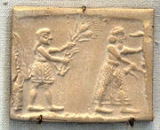
Uruk period
Encyclopedia
The Uruk period existed from the protohistoric
Chalcolithic to Early Bronze Age period in the history of Mesopotamia
, following the Ubaid period
and succeeded by the Jemdet Nasr period
. Named after the Sumerian city of Uruk
, this period saw the emergence of urban life in Mesopotamia. It was followed by the Sumerian civilization
. The late Uruk period (34th to 32nd centuries) saw the gradual emergence of the cuneiform script
and corresponds to the Early Bronze Age.
These early city-states had strong signs of government organization (though social stratification was not strongly evident until very late in this period and the beginning of the Early Dynastic Period, beginning around 3100 BC), evident even in items such as cheap, mass-produced beveled rim bowls which were made to be discarded. These bowls may have been handed out at community outings, such as large-scale constructions. The cities grew to cover up to 250 acres (1 km²) and up to 10,000–20,000 people by the end of the period.
Periodization is after archaeological layers at Uruk
. Thus, Uruk XVIII–XIV are not part of the "Uruk period" proper but are comprised by the Ubaid period
. The Uruk period proper corresponds to the layers Uruk XIV–IV, with the late phase Uruk IV lasting ca. 3300–3100 BC. Uruk III reaches up to 3000 BC and into the Early Dynastic period (not to be confused with the Ur III period of the 21st century BC, where the numbering refers to royal dynasties, not archaeological layers).
Protohistory
Protohistory refers to a period between prehistory and history, during which a culture or civilization has not yet developed writing, but other cultures have already noted its existence in their own writings...
Chalcolithic to Early Bronze Age period in the history of Mesopotamia
Mesopotamia
Mesopotamia is a toponym for the area of the Tigris–Euphrates river system, largely corresponding to modern-day Iraq, northeastern Syria, southeastern Turkey and southwestern Iran.Widely considered to be the cradle of civilization, Bronze Age Mesopotamia included Sumer and the...
, following the Ubaid period
Ubaid period
The Ubaid period is a prehistoric period of Mesopotamia. The tell of al-`Ubaid west of nearby Ur in southern Iraq's Dhi Qar Governorate has given its name to the prehistoric Pottery Neolithic to Chalcolithic culture, which represents the earliest settlement on the alluvial plain of southern...
and succeeded by the Jemdet Nasr period
Jemdet Nasr period
The Jemdet Nasr period is an archaeological culture in southern Mesopotamia that is generally dated to 3100–2900 BCE. It is named after the type-site Jemdet Nasr, where the assemblage typical for this period was first recognized. Its geographical distribution is limited to south–central Iraq...
. Named after the Sumerian city of Uruk
Uruk
Uruk was an ancient city of Sumer and later Babylonia, situated east of the present bed of the Euphrates river, on the ancient dry former channel of the Euphrates River, some 30 km east of modern As-Samawah, Al-Muthannā, Iraq.Uruk gave its name to the Uruk...
, this period saw the emergence of urban life in Mesopotamia. It was followed by the Sumerian civilization
Sumer
Sumer was a civilization and historical region in southern Mesopotamia, modern Iraq during the Chalcolithic and Early Bronze Age....
. The late Uruk period (34th to 32nd centuries) saw the gradual emergence of the cuneiform script
Cuneiform script
Cuneiform script )) is one of the earliest known forms of written expression. Emerging in Sumer around the 30th century BC, with predecessors reaching into the late 4th millennium , cuneiform writing began as a system of pictographs...
and corresponds to the Early Bronze Age.
These early city-states had strong signs of government organization (though social stratification was not strongly evident until very late in this period and the beginning of the Early Dynastic Period, beginning around 3100 BC), evident even in items such as cheap, mass-produced beveled rim bowls which were made to be discarded. These bowls may have been handed out at community outings, such as large-scale constructions. The cities grew to cover up to 250 acres (1 km²) and up to 10,000–20,000 people by the end of the period.
Periodization is after archaeological layers at Uruk
Uruk
Uruk was an ancient city of Sumer and later Babylonia, situated east of the present bed of the Euphrates river, on the ancient dry former channel of the Euphrates River, some 30 km east of modern As-Samawah, Al-Muthannā, Iraq.Uruk gave its name to the Uruk...
. Thus, Uruk XVIII–XIV are not part of the "Uruk period" proper but are comprised by the Ubaid period
Ubaid period
The Ubaid period is a prehistoric period of Mesopotamia. The tell of al-`Ubaid west of nearby Ur in southern Iraq's Dhi Qar Governorate has given its name to the prehistoric Pottery Neolithic to Chalcolithic culture, which represents the earliest settlement on the alluvial plain of southern...
. The Uruk period proper corresponds to the layers Uruk XIV–IV, with the late phase Uruk IV lasting ca. 3300–3100 BC. Uruk III reaches up to 3000 BC and into the Early Dynastic period (not to be confused with the Ur III period of the 21st century BC, where the numbering refers to royal dynasties, not archaeological layers).
See also
- History of SumerHistory of SumerThe history of Sumer, taken to include the prehistoric Ubaid and Uruk periods, spans the 5th to 3rd millennia BC, ending with the downfall of the Third Dynasty of Ur around 2004 BC, followed by a transition period of Amorite states before the rise of Babylonia in the 18th century BC. The first...

